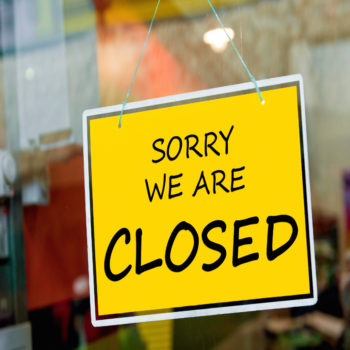Why Retailers Can’t Afford to Close the Door on Convenience
by Hugh Williams on 12th Mar 2018 in News

Retailers have been struggling to entice cautious shoppers to spend. Weathering the post-January slump and optimising convenience both online and in-store will help ensure they’re staying relevant as consumers tighten their purse strings, as Patrick Gallagher (pictured below), CEO, CitySprint Group, explains exclusively for RetailTechNews.
The UK retail sector is facing an extended period of uncertainty. Despite astonishing resilience in 2017, the falling pound and squeezed household finances mean consumer confidence is finally waning and having a knock-on effect on UK shoppers’ spending habits.
According to the most recent figures from Springboard, footfall on UK high streets fell 2.4% year-on-year for the week ending 17th February – highlighting the fact that retailers have been struggling to entice cautious shoppers. This unwillingness to spend is reinforced by the annual Shoppercentric ‘Shopper Stock Take’ report, which revealed that four-in-five shoppers say that they are now being careful to avoid waste, and three-in-four are avoiding buying things they don’t need.
In the first few months of 2018, we’ve already seen a number of big retail chains go into administration. And with others facing similar difficulties, it’s all evidence of an incredibly tough climate. This, paired with declining customer footfall, falling retail sales, and increased competition – both on the high street and online – means that it’s now more important than ever for retailers of all sizes and across all sectors to pull out all the stops to remain competitive.
But what can retailers do to face up to these challenges and come out fighting?
Prioritise customer experience all year round
Over the past decade, advances in technology have radically changed the way that we shop, transforming it from a nine-to-five activity into something that can be done anytime, anywhere.
In the last few years alone, we’ve witnessed a colossal boom in mobile shopping. Research from eMarketer states that global m-commerce sales rose 40% last year to USD$1.357tn (£1tn), now accounting for 60% of total global e-commerce. Changes like this have taught consumers to shop differently – altering and raising their expectations when making purchases across all channels. Consumers today expect to shop how and when it’s most convenient for them.

Patrick Gallagher, CEO, CitySprint Group
But while this transformation has been immense, the overall mission for retailers has stayed the same: creating a seamless experience built around the needs of their customers.
Retailers must remember to place their shoppers at the heart of their offer, prioritising customer experience both in store and online all year round – not just during peak season – optimising the shopper journey from point of purchase, throughout the fulfilment cycle. With online retail increasingly cutting out the need for a customer to set foot in a physical store, deliveries are rapidly becoming the only point of contact some brands have with their shoppers. Getting this experience right, ensuring it adequately reflects the values and nature of the retailer, is therefore critical.
Implement convenient end-to-end solutions
It’s fair to say that consumers today are nearing peak convenience. Even in the hardest of times, when taking utmost care with where and how they spend their money, people struggle to let go of the convenience they’ve become accustomed to in better times. Whether a shopper is making their next purchase in store or via their smartphone, they’re naturally attracted to the products and services that will fit seamlessly around their busy lives.
As a result, retailers need to find ways of incorporating this convenience into their ongoing offer or risk consumers passing them by for their competitors.
Convenient deliveries are increasingly being used by retailers as a point of differentiation, transitioning from what was once considered a nice addition to a 'must have'. Offering shoppers a host of different delivery options – from same-day to next-day and specified hour – tailored to their individual needs and preferences, whether shopping online or in-store, is rapidly becoming the norm.
Retailers with a full range of convenience-boosting services in place – from easily navigable online platforms, to the availability of different payment methods, and a suite of flexible delivery options – are the ones that stay front-of-mind and attract customers back time and again, despite the increasingly tough economic conditions.
Use tech to tailor the fulfilment offering
The retail delivery sector has undergone a massive transformation thanks to recent advances in technology, enabling retailers to truly meet the needs of their customers. Tech-enabled systems, such as SMS, GPS, and email tracking, as well as algorithms allowing shoppers to choose the day, and even specified hour, of their delivery, mean that finding a “sorry we missed you” card on your doorstep is quickly becoming a thing of the past.
We’re increasingly witnessing retailers appearing that are basing their entire offer around fulfilment, building outwards from an ultra-convenient delivery service. And traditional retailers need to harness the benefits of technology to keep innovating and enhancing their offer in order to keep up with the change.
Don’t forget the importance of returns
Alongside the increase in online retail, we’ve also seen a sharp increase in the number of items being returned. Easy and affordable returns are pivotal to those shopping online, simply because they aren’t able to handle their purchases until they arrive on their doorstep. In fact, returns have become a key sticking point for shoppers, with Metapack research revealing that almost half (49%) have been deterred from making an online purchase due to the retailer’s returns process, and over a third (39%) look at the retailer’s returns policy before making a purchase.
Retailers that incorporate a cheap and simple-to-use returns process are much more likely to see shoppers come back time and again. After all, convenient deliveries are rendered somewhat pointless if a shopper returning unwanted items still has to spend their lunch break queueing at the post office.
So, whilst the year may have got off to a bleak start – and not just in terms of the weather – there is still a huge opportunity for retailers operating against a tough economic backdrop. Prioritising the needs and wants of your shoppers, and building a convenient solution around them, from point of purchase through to deliveries, and even returns, will see retailers develop a loyal shopper base and avoid losing out to the competition. This content was originally published in RetailTechNews.
DataE-CommerceIn-storeTechnology








Follow ExchangeWire